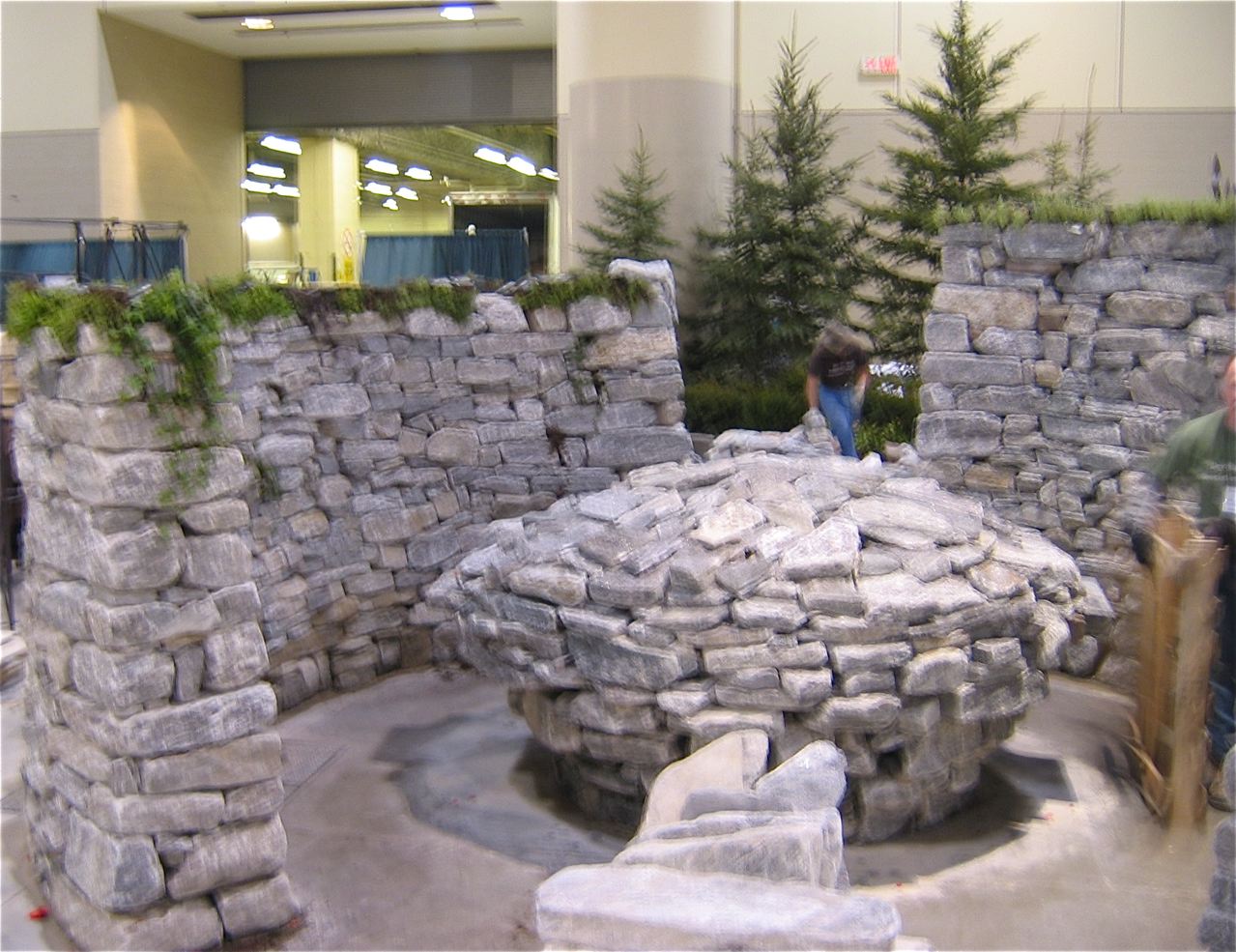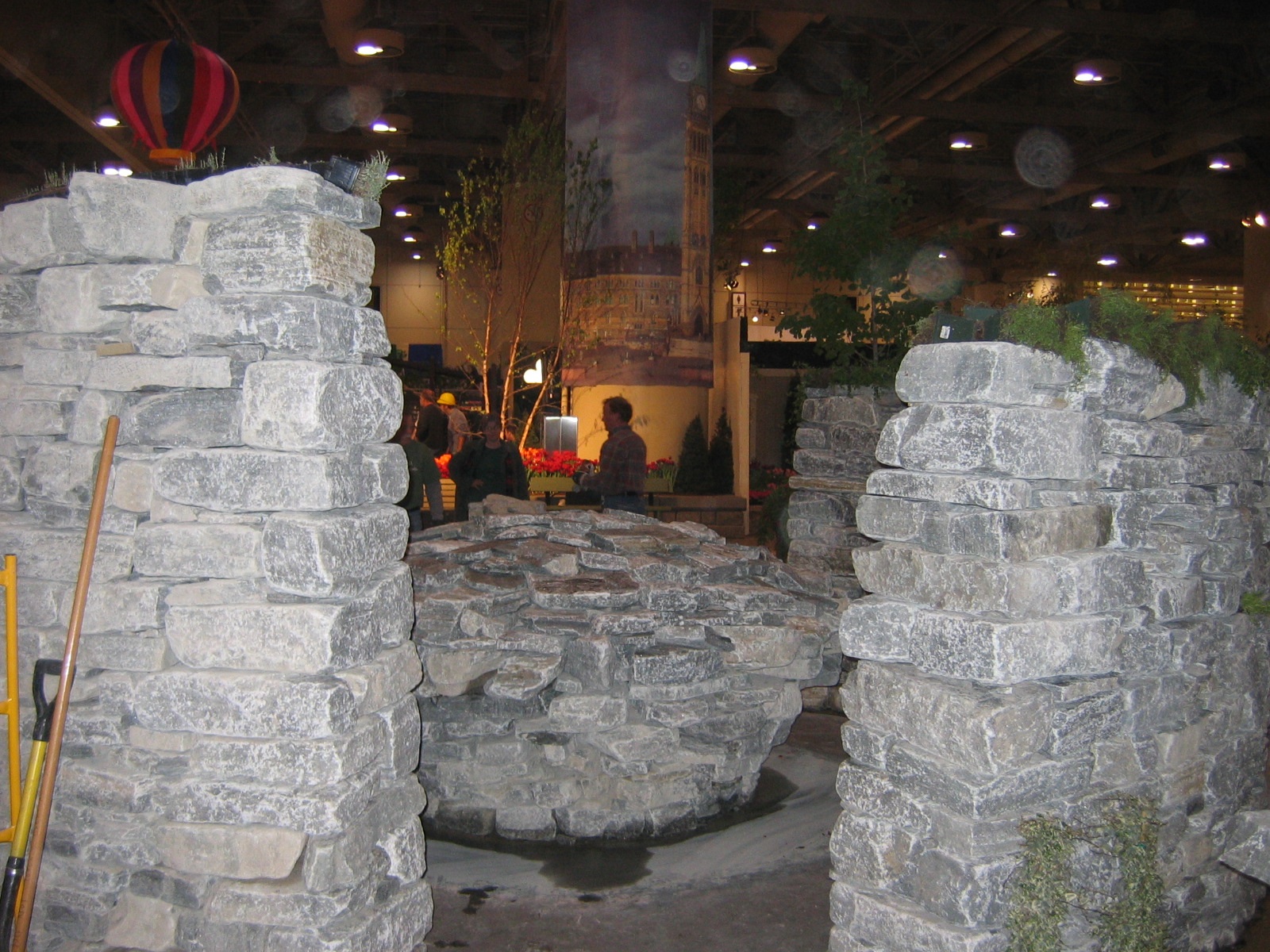
The DSWAC came to build a replica of the Toronto City Hall for Canada Bloom's 2006 theme of "Our Town". About 14 members of the Association constructed the 38 tonne stone garden feature over the 5 days of the show to give people an understanding of the process that goes into transforming random shaped natural material into beautiful structures of free standing stone. As we worked, people remarked not only on how wonderful the garden feature was, but also how peaceful and enjoyable the whole operation was to watch....
I was reminded of how fascinated I was many years ago on a visit to Britain, watching dry stone wallers repairing a section of wall around a garden in Devon. Though the final wall would be a delight to the eyes and an entirely functional structure when it was finished, there was something very satisfying about watching the whole process of people working together building a dry stone wall. It was interesting to consider how time became part of the equation in creating this kind of beauty. A garden grows in many ways and to my mind none of it should be rushed. The stone structures, as they are being built, are very much 'living, growing things' just like the other garden plants and shrubs.
If it's true the most important element of a garden is it's bones, (and the arrangements of stones within a garden surely make up the largest part of a garden's skeleton), then how wonderful it is to appreciate those parts actually 'growing' like the rest of the flowers and shrubs. Garden walls and terraces are not something to be plopped onto a property in a gardening frenzy and then back-filled in a flurry of mechanized activity, but rather something to be taken on as a complement to the steady process of growth and life in a garden.
It shouldn't be necessary to have to leave your house,( or keep the blinds drawn), for the week or two that your landscape contractor rumbles in with all his heavy equipment to whip your garden into shape. Better to be able to watch and enjoy the transformation of natural stones materializing into beautiful shapes and forms gradually and gracefully before your eyes, like all the other living elements of your garden . Instant gardens can't really be that satisfying. If you have the time, surely watching a tree or shrub grow over the years is much more rewarding than dropping them in as full grown specimens. Walls don't take as long as most things to grow but they do better if they are not churned out in prefabricated units, landscape-glued together and built in a crazy rush.
As we approached the period when we would be building our walls at Canada Blooms we took a moment to reflect. We knew it would be challenging as well as rewarding. Just to be able to build with stone together was going to be a pleasure. Working with rocks indoors during the winter is always a treat too. The interest we were going to generate in dry stone walling would be worth all the hustle bustle of the crowded environment of the Metro Convention Centre.
We were all there at Blooms as members of this very loose organization called the DSWAC. All that meant was that if anyone talking to us had questions about walling , or wanted to take a dry stone wall course, they could be directed to the web site. Our hope too was that the DSWAC would be, among other things ,a resource for people to come to find out where they could get wallers to do interesting dry stone projects in their area.
The bottom line was we were there to have fun and remind ourselves that we are not landscapers, but craftsmen and women, who are not inventing something new and trendy , not even doing anything particularly clever, (as if the time worn techniques of dry stone walling somehow needed to be reinvented) but just there to awaken in people a love and interest in dry stone walls.

Lots of work and care and yes, 'time' went into the building our natural stone version of the Toronto City Hall. All the lovely elite blue granite stone was graciously provided by Colonial Stone and Brick in Brunner Ontario. The large space we were allowed to use this year was a delight to work in.
On the opening Gala night John Storm and I , both dressed in National Tartan Kilts, built a small gothic window opening of tumbled stone. Then on Wednesday through Friday Robin Thornrose, Leigh Bamford, Hilary Martin, Carlan Stants,Don Sellar, Mike Patten, Bob Chrystian and Matthew Ring helped build the east and west towers. Evan Oxland came in by bus from Ottawa and Steve Mattera also came from Vermont to help on this project. Bobby Watts dropped by to see us on the Saturday and Steve Fraser joined us too to complete the centre Pod.
The central middle structure which is the Council Chambers, is perhaps the most bizarre feature of the unusual configuration of building shapes we know as the Toronto City Hall . The 4,000-tonne, poured-concrete ellipsoid pod is held three storeys in the air by a single, six-meter thick concrete column in its centre. This mushroom- shaped column plunges 16 meters below floor level into solid bedrock. The pod is generally referred to as "the spaceship" in articles on the building's architecture.
Our problem was how to build this shape ( although much smaller) of pieces of irregular stones. No instant poured concrete column for us.
This meant we had to be thinking about and well practised in the area of 'corbeling' and 'cantilevers' Buiding a dry stone pod is not as easy as it looks. There is a whole area of unpredictability. There are formulas for doing corbelling with brick chimneys and veneers. But again that is using masonry as an adhesive and using all the same size building blocks.
Many people including Andy Goldsworthy have experimented with and perfected the egg shaped dry stone structure we comonly refer to as a cairn. What we were building was basically a cairn but much more flattened, and the outward corbeling was maximized to get a rounded spaceship look instead of just a gradually slanted simple 'reverse batter'. This was extreme walling and was quite a challenge. It was fun to watch the 'stone pod' grow. The structural considerations were enormous and, as some of us found out at the Advanced Class at Bethany last month when we built a 15 tonne dry stone sphere, the solutions were not obvious, nor was the process as intuitive as building an arch or as simple incorporating stiles into a wall
Some of the problems we had to consider were ....
-How far could we step out with our stone and at what rate, as we build using so many different sizes of stones.
-When do we use the few bond stones we have? near the middle? near the bottom? spaced evenly throughout? every other course?
-Could we leave spaces or did it have to be hearted just as well in the overhanging part?
-Narrow pie wedge stones? Just how many would we need? Could we shape the stones we would need during the show?
-Was the 'two over one, one over two' rule still as structurally important or could we get away with more running joints
-Egg shaped stones placed lengthwise into a narrowing space weigh even more towards the outside, and so present a structural problem if we are cantilevering out on all sides. How would we compensate for this?
-How important was counter balancing, and could it be done preemptively and taken away as we lay stones higher up in the spaceship
-Was it safe to use some stones as tracing to complete the look of the rounded surface .
-And what was the minimum base we could go with (to still have the mass and weight we need) and get that convincing spaceship look?
In the end the final Pod structure that we created was quite impressive. It was sturdy enough to allow people to walk between it and the 2 towers to get a better look at.
On one of the last days that we worked at Blooms we added one of the arches that goes over the Nathan Phillips Centre skating rink. People were amazed at this structure as well, though it was not as difficult as the City Hall 'Spaceship'. Everyone pulled together, including Andrew Stants and Ed Mills, at the end of the show to take down the huge 38 tonne dry stone structure in an amazing 2 hour disassemble- re-stack-on-skids and shrink-wrap marathon.

